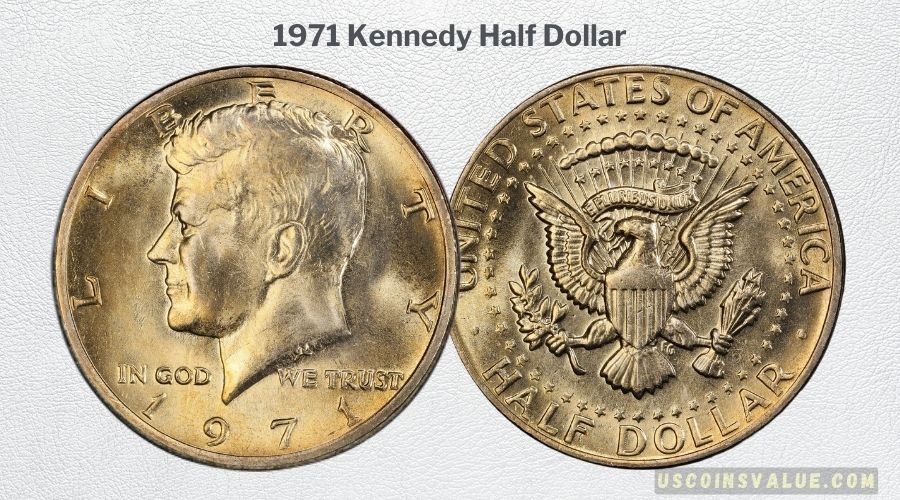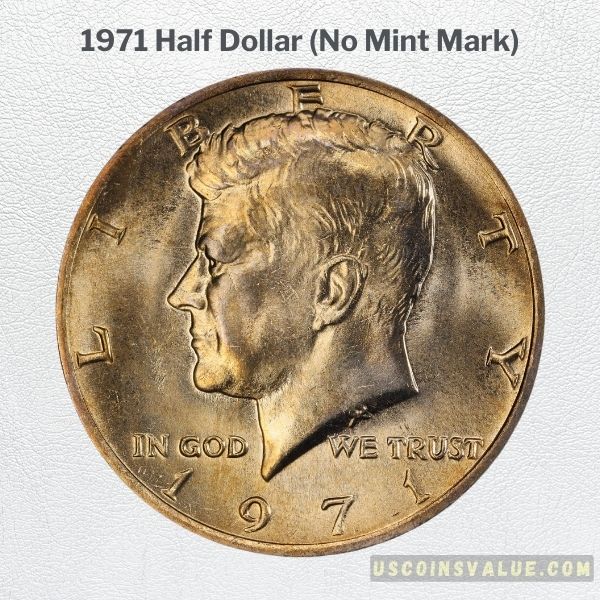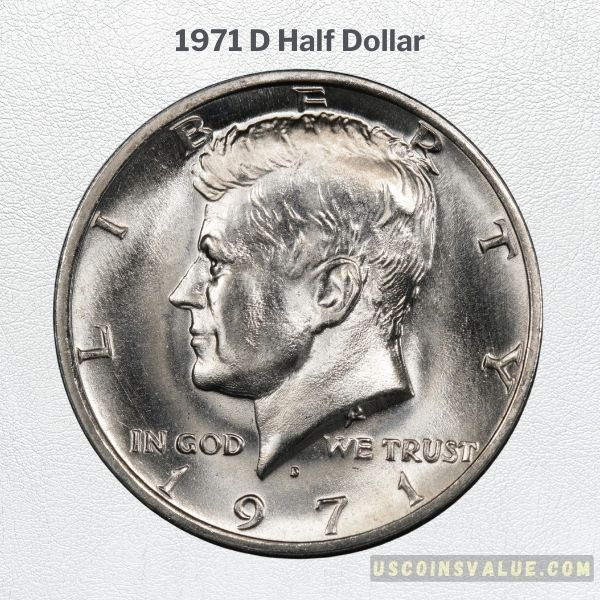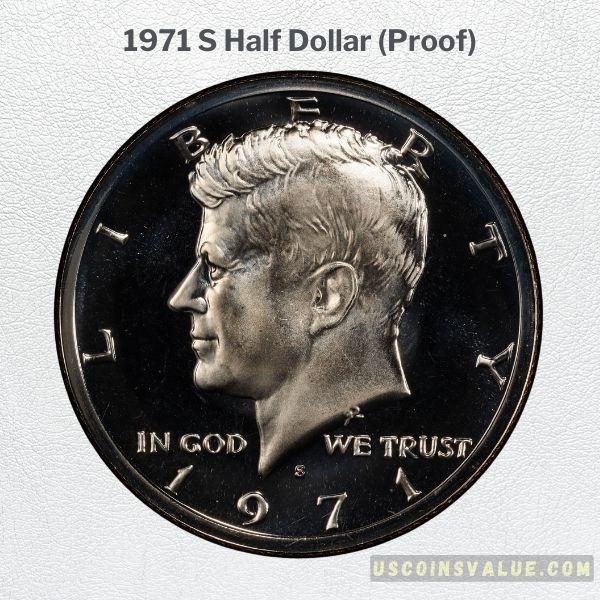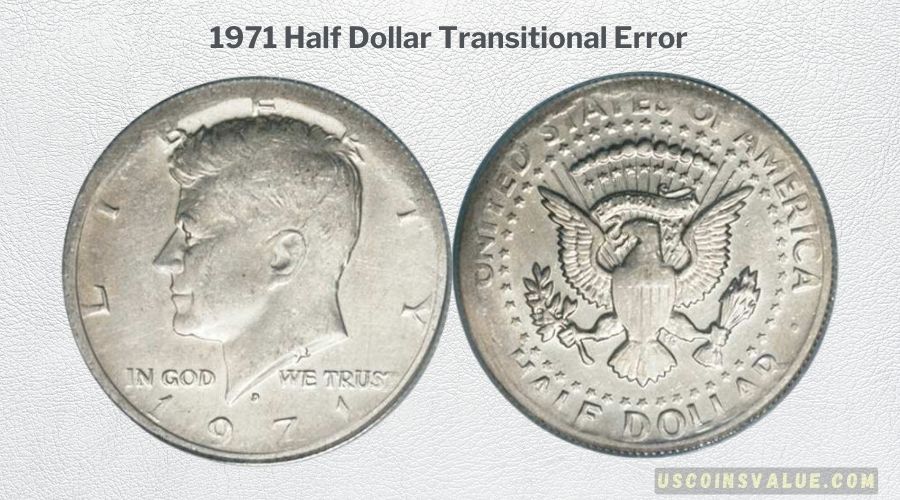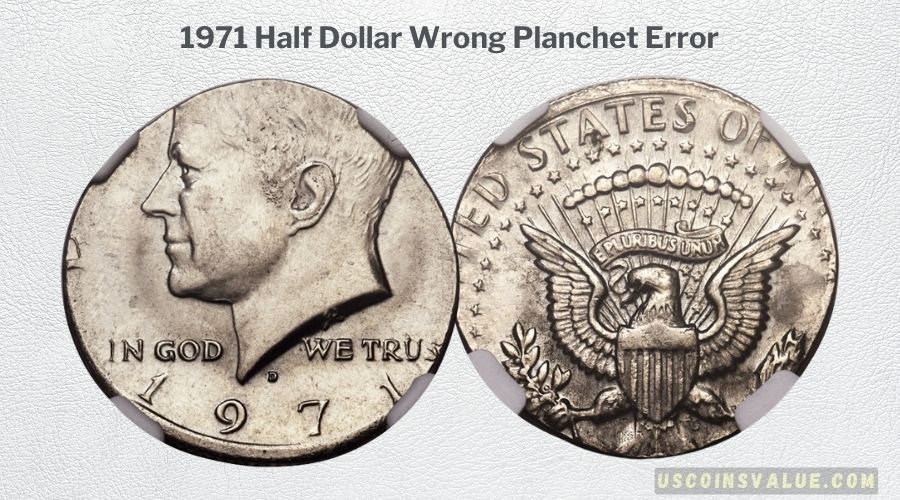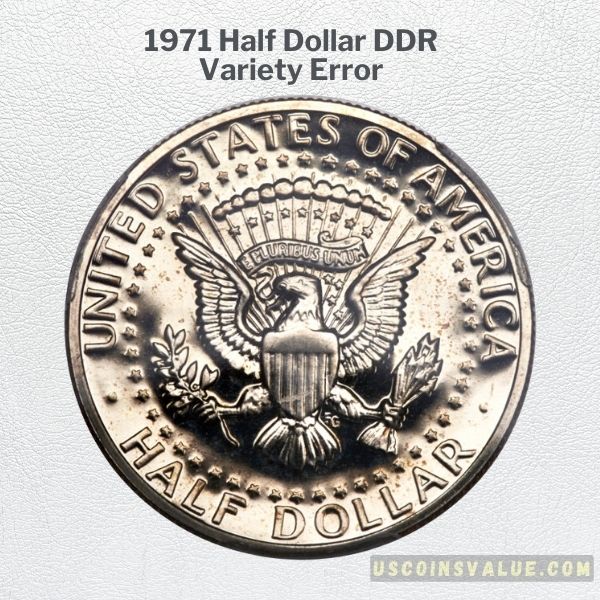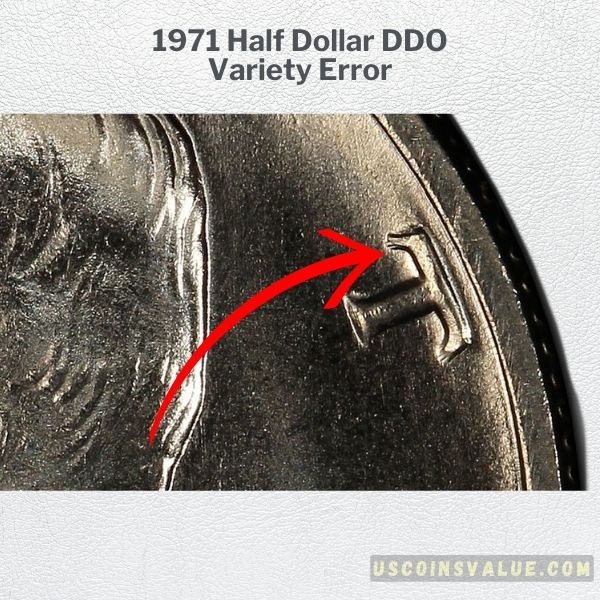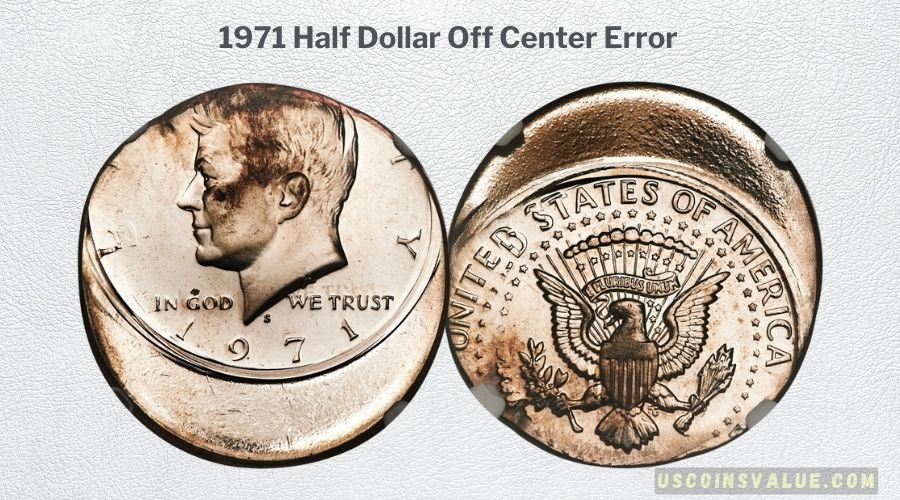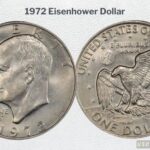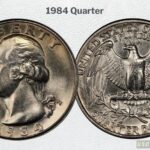The most valuable 1971 Kennedy Half Dollar sold for $13,000 in 2018. Its value is that high due to a unique transitional error that occurred in 1971 when the U.S. Mint was doing away with silver in favor of copper-nickel coins for minting half dollars.
This error and a few other factors are the biggest contributors to the high value of these half dollars. Here are the three major considerations that can help you find the most valuable 1971 half dollars:
- Coin Condition: Regular Strike coins are worth more than $1,000 in MS67 or higher, while Proof Coins are worth more than $1,000 from PR68 DCAM.
- Silver 1971 half dollars: Transitional Errors occurred in 1971 when silver coins were mistakenly minted. Coins with this error have sold for more than $12,000 at auctions.
- Mint Errors: Major errors such as DDO and “Wrong Planchet” increase the half-dollar value up to $3,000 in the best grade conditions.
The comprehensive guide here will take you through the 1971 half-dollar’s history, design, features, errors, and value in today’s market. Collectors and enthusiasts should pay attention to the trends in the prices and demand to valuate their collectibles better.
1971 Half Dollar Value Summary
Below is the 1971 half dollar value chart based on grade condition and strike:
| 1971 Half Dollar and Coin Grade | 1971 Half Dollar No Mint Mark (MS) | 1971 D Half Dollar (MS) | 1971 S Half Dollar (PR – DCAM) (PR) |
| 60 | $5 | $5 | $4 – $6 |
| 61 | $6 | $6 | $4 – $6 |
| 62 | $7 | $7 | $4 – $6 |
| 63 | $9 | $9 | $4 – $7 |
| 64 | $24 | $10 | $4 – $8 |
| 65 | $100 | $16 | $4 – $10 |
| 66 | $375 | $25 | $6 – $15 |
| 67 | $2,000 | $70 | $7 -$32 |
| 68 | N/A | $3,750 | $10 – $115 |
| 69 | N/A | N/A | $18 – $1,050 |
| 70 | N/A | N/A | N/A |
Note:
- The N/A in columns without a price guide does not mean the coins are rare. Instead, it shows there isn’t enough data or coins to publish an average price estimate.
- The grades (60 – 70) represent the particular coin’s grading prefix, i.e., MS60-MS70 for Regular Strike coins and PR60-PR70 for Proof coins.
1971 Kennedy Half Dollar Background
The Kennedy Half Dollar Series (Type 3, Copper-Nickel Clad) was first minted in 1971 and is still the same series of half dollars produced to date, albeit not for circulation since half dollars are not used in daily commerce anymore.
The Coinage Act of 1965 saw to it that dimes and quarters would shift from a silver composition to a copper-nickel-clad alloy.
In 1971, the U.S. Mint made the same decision to stop making half dollars using silver planchets and instead go for a copper-nickel composition made up of 75% copper and 25% nickel over a copper core.
This solved the silver shortage issue that had plagued the nation for the better part of the late 1960s. As with many transitions, this year featured coins with transitional errors – these are errors that occur when a coin’s composition is changed from one metal to another, leading to production mistakes.
The three types of half dollar made in 1971 include:
- 1971 (No Mint Mark) Half Dollars – Made in Philadelphia and does not bear any mint marks.
- 1971-D Half Dollars – Made in Denver. These coins bear a “D” mint mark on the obverse.
- 1971-S Half Dollars – Made in San Francisco. These coins bear an “S” mint mark on the obverse.
Here is a quick summary of the coin’s mintage and metal composition:
| Coins | Mint | Total Mintage | Metal Composition |
| 1971 No Mint Mark Half Dollar | Philadelphia | 155,640,000 | 75% copper, 25% nickel over a pure copper core |
| 1971-D Half Dollar | Denver | 302,097,424 | 75% copper, 25% nickel over a pure copper core |
| 1971-S Half Dollar | San Francisco | 3,220,733 | 75% copper, 25% nickel over a pure copper core |
Other features:
- Obverse (heads) design: Designed by Gilroy Roberts, features a portrait of President J.F. Kennedy facing the left side.
- Reverse (tails) design: Designed by Frank Gasparro, it features the eagle design seen on the Presidential Seal.
- Weight: 11.34 grams
- Diameter: 30.60 millimeters
- Edge: Reeded
What Makes A 1971 Kennedy Half Dollar Rare
1. Coin Condition
Its condition is the most fundamental determinant of a 1971 half dollar’s value.
A coin in pristine, uncirculated condition, with no signs of wear or tear, commands a higher price than a coin that has circulated extensively and exhibits scratches, dents, or other blemishes.
The Sheldon Scale is the grading system used by professional numismatic organizations, such as the Numismatic Guaranty Corporation (NGC) and the Professional Coin Grading Service (PCGS).
Poor (P-1) is the lowest grade and Mint State 70 (MS70) is the highest grade. Circulated coins have the least grades (graded from P-1 to AU55), while uncirculated coins are more valuable (graded from MS60 – MS70).
Proof coins are uncirculated coins with the most pristine finishes and superior strikes. They are made for collectors and graded from PR60 – PR70. However, since they are sold directly as collectibles, their value is less due to their accessibility.
The scale provides a standardized assessment of coin condition. A higher grade translates into a higher value.
For example, MS68 half dollars from Denver are worth $3,750 while MS67 is worth $70. MS63 coins are even cheaper, valued at less than $10, while circulated coins between P-1 and AU55 are worth the coin’s face value ($0.50) or less than $1.
Grading is a highly subjective endeavor, and it is best to offer the coin to professionals like PCGS or NGC to have it graded. This gives you a better chance to appraise the coin to its true value but also has the downside of being expensive since you will have to pay more than $15 to grade one coin.
2. Silver Content
1971 half dollars with silver content are transitional error coins (particularly “Wrong Planchet” error) where some half dollars were struck with 90% silver planchets from 1970 rather than copper-nickel planchets from 1971.
The highest-priced 1971 half dollar has this error.
How can you tell if a 1971 half dollar is silver?
The best way to differentiate half dollars with silver content is to weigh them. Silver coins weigh 12.50 grams compared to 11.34 grams of copper-nickel-clad coins.
3. Mint Errors
Mint errors, deviations from the intended design or manufacturing process, can significantly enhance the value of a 1971 half dollar.
These errors, often caused by mechanical malfunctions or human mishaps, introduce uniqueness and attention to the coin. Common mint errors include double die errors, off-center strikes, and clipped planchets.
The rarity and significance of the error determine the extent to which it elevates the coin’s value. For instance, a 1971 half dollar with a prominent double die error (DDO) could fetch hundreds or even thousands of dollars.
However, a common error doesn’t affect the price of a coin significantly. In some cases, it can lower the value of the half dollar.
Value of Each 1971 Kennedy Half Dollar
Here is an overview of how much each 1971 half-dollar coin is worth:
1. 1971 Half Dollar (No Mint Mark) Value
NGC evaluates a circulated condition Philadelphia 1971 half dollar between $0.60 and $0.75. On the other hand, the highest-graded half dollars in uncirculated conditions are worth $2,050.
As per the USA Coin Book, the coin is worth $3.38 or more in Brilliant Uncirculated Condition.
Online trends show a declining demand for the 1971 Philadelphia Half Dollars collectability.
MS66 or higher coins were once worth $2,000 but are now less. According to PCGS, one reason for this is that coins above MS66 are almost non-existent, with less than 200 examples estimated to have survived.
Coins in the most common uncirculated grades (MS60 -MS64) have been relatively stable over the years, worth $5 – $50 or more depending on the condition.
For those looking to make a good profit, you will be happy to know any of these coins in uncirculated conditions will cost more than $5 in the open market, a price that can go up to $3,000.
The table below shows the highest auction prices realized for 1971 (no mint mark) half dollars:
| Grade | Price | Firm | Sale Date |
| MS67 | $2,900 | eBay | 2023 |
| MS67 | $1,560 | Heritage Auctions | 2018 |
| MS67 | $1,200 | Stack’s Bowers | 2023 |
| PCGS Genuine | $300 | eBay | 2021 |
| MS66 | $280 | Heritage Auctions | 2013 |
2. 1971 D Half Dollar Value
The demand for these Denver coins has remained relatively stable over the years.
The highest known grade is MS68, valued at $3,750. The most common grades in the uncirculated variety according to PCGS, are MS62- MS66, with over 3,000 graded coins. These common varieties are valued between $7 and $25.
As per the USA Coin Book, 1971-D half dollars are worth $3.38 or more in Brilliant Uncirculated Condition (MS65), which is $10 less compared to PCGS estimates.
Any 1971-D half dollar in uncirculated conditions is worth more than $5 in the open market, a price that can go up to $3,700. For the uncirculated coins, the price is between the coins’ face value of $0.50 and $1.
The table below shows the highest auction prices realized for 1971-D half dollars:
| Grade | Price | Firm | Sale Date |
| AU55 | $3,910 | Goldberg Auctioneers | 2003 |
| MS68 | $3,120 | Heritage Auctions | 2019 |
| MS63 | $1,725 | American Numismatic Rarities | 2006 |
| MS68 | $1,586.25 | Legend Auctions | 2020 |
| MS68 | $1,500 | eBay | 2022 |
3. 1971 S Half Dollar (Proof) Value
Proof coins are not as valuable as Regular Strike coins mentioned above. They are targeted at collectors; hence, their demand is lower than that of other coins.
However, 1971-S Proof half dollars can still be valuable if they are in the best possible conditions, PR69 DCAM.
PR prefixes do not just grade proof coins’ conditions. Suffixes like DCAM and CAM are also used.
DCAM (Deep Cameo) is the highest quality strike, referring to coins with sharp details and deep frosting. On the other hand, CAM (Cameo) is the second-highest quality level referring to coins with frosting design. Regular PR (Proof) coins have the least striking of the three but still feature extra sharp details.
Regular PR coins are worth $18 in PR69 and $4 – $10 in PR60 – PR69.
A CAM coin is worth $80 at PR69CAM. However, those between PR60CAM and PR68CAM are worth $5 and $24, respectively.
Finally, DCAM coins graded PR69DCAM are worth $1,050. Those between PR60DCAM and PR68DCAM are worth $6 and $115, respectively.
The prices increase once you take the coin to auctions. The table below shows the highest auction prices realized for 1971-S half dollars:
| Grade | Price | Firm | Sale Date |
| PR69 DCAM | $3,995 | Heritage Auctions | 2015 |
| PR69 DCAM | $2,703 | Heritage Auctions | 2003 |
| PR69 DCAM | $2,585 | Heritage Auctions | 2013 |
| PR69 DCAM | $2,475 | eBay | 2018 |
| PR69 | $2,453 | eBay | 2016 |
1971 Half Dollar Errors
Below are the most valuable 1971 half dollar errors to look out for:
1. Transitional Error
The main transitional errors in 1971 half dollars were the silver planchet errors, where silver blanks were used instead of copper-nickel clad blanks.
They are the most valuable 1971 half dollars, for example, this one-of-a-kind Proof coin, PR69 DCAM /PF69 Ultra Cameo, that sold for $12,000 in 2019 at Heritage Auctions.
Other examples include this AU55 “Struck on 40% Silver Planchet” coin that sold for $6,037.50 in 2003 at Heritage Auctions and another sold by South Florida Coins Collectibles for $13,000 in 2018.
2. Wrong Planchet Error
Apart from the silver planchet errors, the 1971 half dollars also exhibited special mistakes like the “Struck on a Five Cent Planchet,” where nickel planchets were used instead of half dollar blanks.
An example is the MS64 coin that sold for $2,280 in 2018.
Other examples include:
- MS64 “Struck 30% Off Center on a Mexican 50 Centavos Planchet” sold for $1,880 in 2013.
- AU55 “Struck on Underweight Planchet” sold for $161 in 2007.
3. DDR (Double Die Reverse) Variety
A DDR error happens when the design elements on the dies used in production have imperfections with doubled elements. This causes the struck coin to have doubled details like doubled letters and doubled image outlines.
When the error happens on the obverse, it is called a DDO (Double Die Obverse) error, while on the reverse, it is called a DDR (Double Die Reverse) error.
An example of this coin is the PR67 coin that sold for $2,585 in 2016.
4. DDO (Double Die Obverse) Variety
Officially known as the 1971-S DDO FS-801, these errors were so common that they became a variety. Several have sold at auctions for more than $1,000, including this PR67 coin that sold for $1,821 in 2013 at Heritage Auctions.
5. Off Center Errors
Off Center is an error that occurs when the dies used to strike a coin are misaligned, causing design elements to be struck off-center on the coin.
The error can also include other common mistakes like Double Strikes. An example is this “Double Struck, Both Strikes Off Center” sold for $2,520 in 2022. It features a coin struck off-center but also struck twice.
Conclusion
The value of a 1971 half dollar is not simply the sum of its individual factors; rather, it is a product of their combined influence.
A coin in the highest-gradable condition with silver content and a unique mint error commands the highest price. The lowest prices go to 1971 circulated coins with no errors and the least possible coin conditions.
All in all, if you’re looking for the most valuable 1971 half dollars, start by prioritizing 1971 half dollars with silver content, MS67 grades or higher, and coins with valuable mint errors like the DDR and “wrong planchet” errors.

